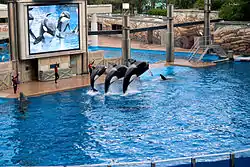鯨豚水族館
鯨豚水族館 是飼養鯨豚類動物的水族館,多以“海洋公園”或“海洋世界”命名,有些为大型动物园或主题公园的一部分,往往还包含其他动物和景点。在水族馆内,多數鯨豚類被飼養在水池中,少數飼養在半開放的海灣或網箱中,用於商業演出或科研。被饲养的鯨豚類中最常见的是宽吻海豚,因其相對容易训练且在人工飼養下的寿命較长。鯨豚類的贸易受到国际管制,但在人工驯养方面並無統一的國際標準,如飼養池的最小尺寸和其他规格等,各国均有所不同[1]。
自 1860 年代起,人們便一直在飼養鯨豚類。世界上首個经营性鯨豚水族館为美国佛羅里達海洋世界,開設於 1938 年。直到 1960 年代,鯨豚類表演的受欢迎程度还在迅速上升[2] 。1970 年代以来,人们对动物福利的日益关注促成了更加严格的监管,这最终导致一些国家关闭了部分場館。尽管存在这种趋势,但欧洲、北美和日本目前仍有許多鯨豚水族館。
鯨豚水族館拉近了人类与鲸豚类动物之間的距離,使人們得以更為直觀地認識和欣賞鲸豚类。然而,将原本属于海洋的鲸豚类饲养在狭小的人造水池内,不仅剝奪了它们的自由,同时嚴苛的訓練任務也带給它们沉重的精神負擔,不少人工饲养的鲸豚类都表现出严重的抑郁、焦虑和狂躁情绪,因此驯养鲸豚类用作商演被普遍认为是对它们的残害虐待。当前鯨豚水族馆已成為極富爭議性的話題,許多動物保護組織都呼吁人们拒绝动物表演,促使此类机构退出历史舞台。
歷史沿革
鯨豚類的人工飼養,始於 1859 年的美國波士頓水族公園和紐約市巴納姆氏美國博物館[3][4],而世界上首個將鯨豚類用於娛樂性商業演出的水族館,是 1938 年成立於佛羅里達州圣奥古斯丁市的佛羅里達海洋世界,该场馆开启了訓練海豚表演雜技的先例,使更多的水族馆开始經營海豚表演[2]。在 1960 年代的美國,自 1963 年的电影《Flipper》和次年的電視連續劇《Flipper》播出以後,驯养海豚用作娛樂表演越来越受欢迎。1966 年,第一只海豚出口到欧洲。由于缺少法律約束和对动物福利的关注,鯨豚水族馆在過去的幾十年間迅速發展,遍及世界各國。
1972 年美國通過了《海洋哺乳動物保護法》,加上人們逐漸重視動物福利,迫使世界各地的许多鲸豚水族馆关闭。一个突出的例子是英國,在 1970 年代早期,英國至少有 36 處鯨豚類表演場所,但到了 1993 年已全部關閉[5]。匈牙利的最后一个鯨豚水族館也在 1992 年关闭。2005 年,智利和哥斯达黎加都禁止人工飼養鯨豚類[1]。然而截至 2010 年,全欧洲仍有约 60 家鲸豚水族馆[6],日本、美國和墨西哥也有相当数量的鯨豚水族馆。
參考文獻
- (PDF). 2006 [22 November 2009]. (原始内容 (PDF)存档于8 March 2017).
- "Following P.T. Barnum's ill-fated display of white whales in his New York Museum in 1860, it was not until 1913 that cetaceans were again seen in captivity, this time when C. H. Townsend, curator of the New York Aquarium, stumbled upon the idea exhibiting dolphins as an unbeatable novelty to attract the crowds.", "During feeding time at Marine Studios, it is said, dolphins gradually fell into the habit of jumping up to catch the fish that were thrown to them, and this miniature spectacle always amused the public, the keepers and curator. Then a year later in 1939, Cecil M. Walker, then responsible for maintenance of the water purification pumps on the night-shift, observed one evening how a dolphin pushed a pelican feather across the surface of the water towards him. "Just for the hell of it" he took the proffered feather and threw it back into the water, whereupon, to his great surprise, the dolphin brought it back again. The game continued with Walker experimenting with a ball, an inner tube of a bicycle, small stones and other objects. As the game took shape with other dolphins joining in the act, it began to resemble the repertoire seen today in every dolphinarium in the world.", quotes from The rose-tinted menagerie.
- The Whale Sanctuary Project, Back to Nature. . The Whale Sanctuary Project. 2017-06-06 [2018-06-04].
- . Smithsonianmag.com. 2015-07-20 [2018-06-04].
- "In the golden heyday of the industry, there were at least 36 assorted dolphinaria or itinerant dolphin shows in the UK.", quote from The rose-tinted menagerie
- Oceancare:Dolphinariums in Europe 的存檔,存档日期2010-06-13., retrieved November 16, 2009
